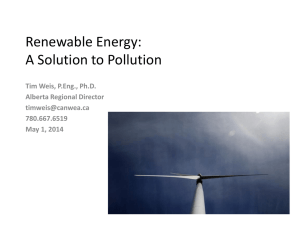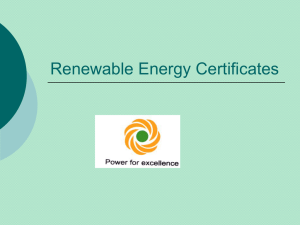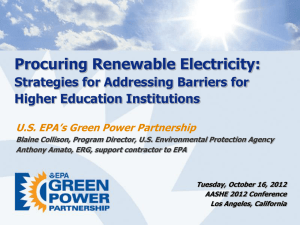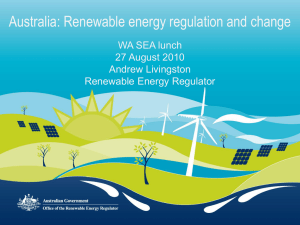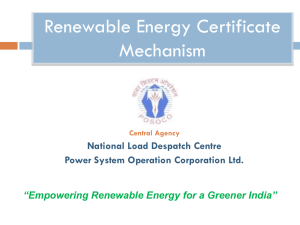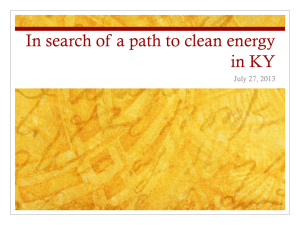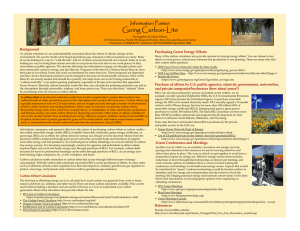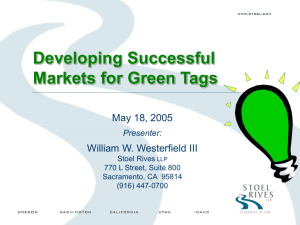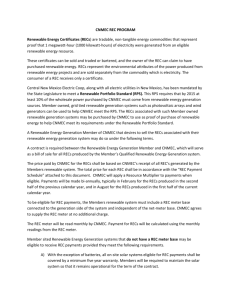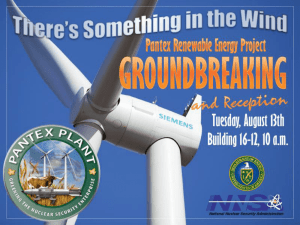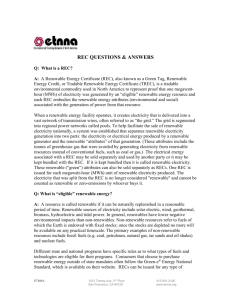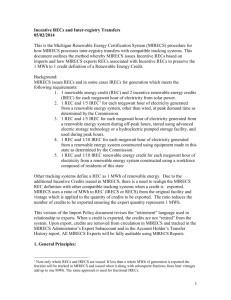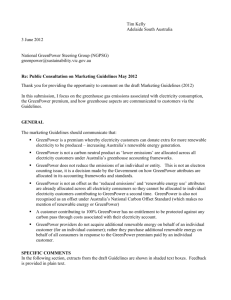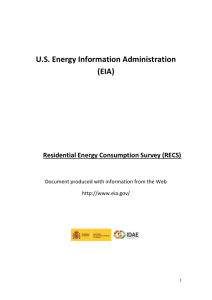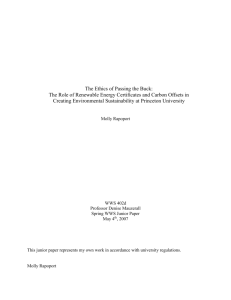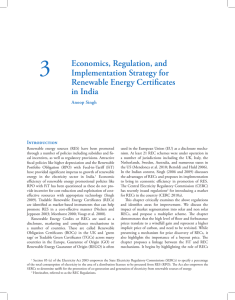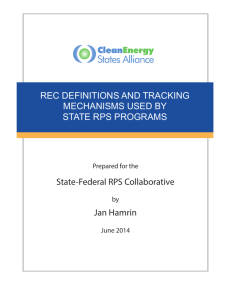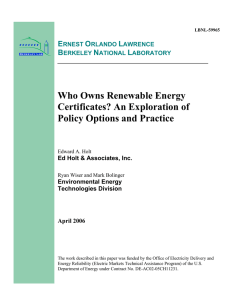PPT Slides - Advancing Education for Sustainability
advertisement
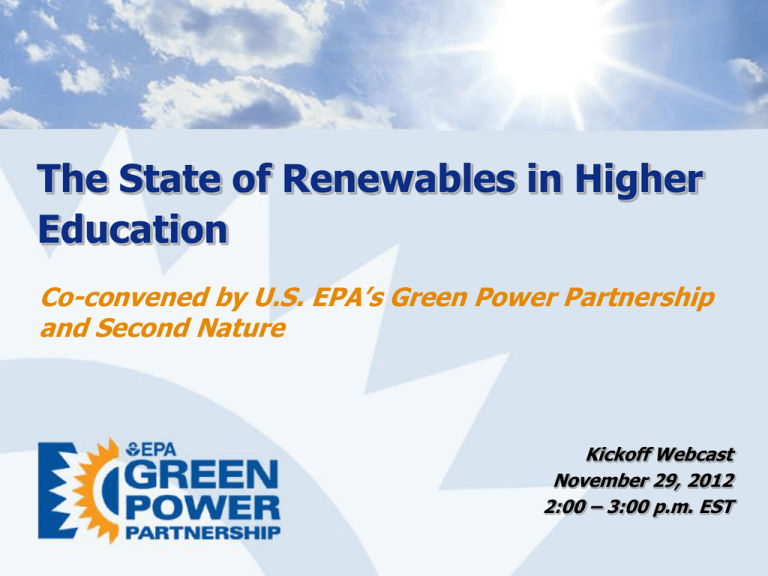
The State of Renewables in Higher Education Co-convened by U.S. EPA’s Green Power Partnership and Second Nature Kickoff Webcast November 29, 2012 2:00 – 3:00 p.m. EST What is Green Power? Electricity generated from natural resources that replenish themselves over short periods of time, including the sun, wind, moving water, organic plant and waste material (biomass), and the Earth’s heat (geothermal). Biogas Geothermal Solar Biomass Small-Hydro Wind 2 Green Power Procurement Options Renewable Energy Certificates (RECs) Green Power Electricity Products The environmental “attributes” of electricity generated from renewable resources (1 REC = 1 MWh) Attributes are based on the generation technology type and age, geographic location, and time of generation Does not include the underlying electrons – “unbundled” a.k.a. Green Tags, Renewable Energy Credits Green power offered by utility suppliers that is all, or partially, generated from renewable sources “Bundled” product that includes both the RECs as well as the underlying electrons On-site Generation Install a renewable energy system on-site (e.g. solar panels, wind turbine) Produces both electricity and RECs from the on-site source Self-financed installation or via a third-party PPA To claim “use” of green power, host needs REC ownership 3 Green Power Reduces Scope 2 GHGs Source: GHG Protocol Renewable Energy Certificates (RECs) Long-term REC contracts with credit-worthy counter parties can help finance new renewable projects 5 Purchasing RECs http://apps3.eere.energy.gov/greenpower/markets/certificates.shtml?page=1 U.S. Markets for Green Power Comparison of Compliance and Voluntary Sales Estimated Voluntary Sales by Product Type Compliance markets are driven by state renewable portfolio standards (RPS), which require utilities to procure renewables for a portion of their electricity supplies. Voluntary markets provide residential and commercial end-users with the option to purchase renewable energy for a portion or all of their electricity needs. This market is driven largely by an interest in using cleaner and more sustainable sources of electricity. Residential and Nonresidential Voluntary Sales 7 Source: Status and Trends in U.S. Compliance and Voluntary Renewable Energy Certificate Markets, NREL, 2011 Purchasing From Your Utility Purchasing From Your Utility http://apps3.eere.energy.gov/greenpower/resources/tables/topten.shtml Does NOT Count as Green Power “Standard Offering” (Existing Renewables from the Grid) Example: UNH’s CAP & EcoLine Project 2007: UNH commits to ACUPCC and reduce its emissions 50% by 2020 and 80% by 2050 2009: EcoLine project, a landfill gasto-energy project that uses methane gas from a nearby landfill as the fuel for on-campus power plant. 2009 – 2015: UNH sells RECs to help finance project 2015: UNH begins retaining RECs and associated reduction in carbon footprint 11 Does NOT Count as Green Power KwH Whose RECs Are Sold Value Proposition of Renewables for a College Campus Meet environmental objectives Reduce exposure to fossil-fuel price volatility Deploys quickly & scales up easily Enhance school brand Prospective students Host communities Peer institutions Attract & retain students Manage risk Sustainability goals GHG reduction targets American College & University Presidents Climate Commitment Sustainability and green power is a hot topic on campus Incorporate green power into research initiatives & curricula Drive economic development Higher ed commitments are financeable Domestic energy supply New U.S. jobs Did you know….. - 79% of colleges and universities have conducted a GHG inventory. - 64% of colleges and universities have made a carbon reduction commitment. Source: 2011 College Sustainability Report Card Some Green Power Barriers 1) Local/State Regulations and Policies 2) Scale/Demand 3) Economics 4) Perception Examples of Barriers to Renewable Energy Adoption Green Power Purchase Power/REC cost Transaction cost Unfamiliarity with procurement options Comfort with REC concept Perceived barriers On-site Deployment Up-front capital costs Transaction cost Limited site availability/quality Outside of core competencies System performance risks Maintenance responsibilities 15 Opportunities in Green Power Space for Higher Education Institutions Unique Properties of Higher Education Institutions ….. Engaged stakeholders Financial stability/credit-worthiness Focus on longer timeframes Large geographic footprint Role in civic society ....Offer Unique Opportunities with Renewables Large on-site renewable installations (owned or via PPA) Utility-scale off-site projects Collaborative purchasing Student purchasing for dorm rooms Development of new renewable technologies via research 16 Second Nature – EPA Webcast Series Next Webcast: Third-party Financing of Solar on College and University Campuses Thursday, December 13, 2012, 3:00 p.m. – 4:00 p.m. EST. More information at: Potential Series Additions….(We want your input!) Utility-scale Wind PPA: Lessons Learned Using Reverse Energy Auctions to Procure Green Power Purchasing Groups: Best Practices 17 17 Want to Know More? Basic Information An overview of Green Power Partnership is available on EPA’s website www.epa.gov/greenpower To learn how to enroll in the Partnership, visit: www.epa.gov/greenpower/documents/gpp_partnership_agreement.pdf To see EPA’s Green Power Purchasing Guide, visit: To see EPA’s Green Power Locator, visit: www.epa.gov/greenpower/documents/purchasing_guide_for_web.pdf www.epa.gov/greenpower/pubs/gplocator.htm More Questions? Blaine Collison, 202-343-9139, collison.blaine@epa.gov Anthony Amato (contractor), 781-674-7225, anthony.amato@erg.com 18

